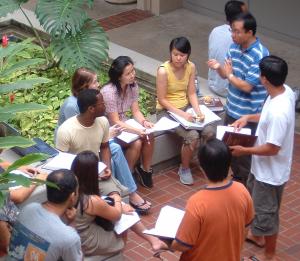UH Law School continues to rank among best in country
 Richardson Law School students meet in the courtyard on the UH Manoa campus.
Richardson Law School students meet in the courtyard on the UH Manoa campus.
News Release from UH Manoa March 13, 2014
The William S. Richardson School of Law, located on the UH Mānoa campus, has once again been ranked among the Top Tier law schools in the country, according to the new 2015 rankings released by U.S. News & World Report.
The Richardson Law School was ranked in 100th place among the 146 best law schools – tying with the University of Oregon Law School, SUNY Buffalo Law School in New York, and Florida International University Law School.
While Richardson Law School was tied for 80th last year, school administrators note that the change this year could be the result of a static bar passage rate. In the July 2013 bar exam, however, the bar passage rate soared seven points to 82 percent, which could indicate a ranking upswing for 2016.
A school’s bar passage rate is one of the complex array of metrics used by the U.S. News consumer guide in making its evaluations, including student/faculty ratios, employment at graduation and nine months afterward, LSAT scores, and acceptance rates.
Dean Avi Soifer called the latest rankings recognition of the excellent education offered by Richardson, one of the country’s smallest and most affordable law schools. “What makes our school exceptional, however, is not measured in these rankings,” Soifer noted. “We are able to personalize the legal education we provide, and our extraordinary diverse students support one another, have fun together, and actually enjoy law school.”
In addition to ranking the full-time day program, U.S. News ranked the Evening Part-Time Program 26th in the country, tied with William Mitchell College of Law in Minnesota, and Cardozo School of Law in New York. According to U.S. News, nationally 14 percent of the total number of law students are enrolled in part-time programs.
Hawai‘i Supreme Court Associate Justice Sabrina McKenna, Class of ’82, noted that the Law School is a powerful community resource offering access to legal training for both full-time and part-time students. McKenna said she puts less stock in rankings than she does in other subjective values: “I don’t think there could be any better law school in equipping people for the challenges of the future – the challenges of bringing together people of different cultures and backgrounds to solve the world’s problems. This starts with what no other school can offer: the opportunity to learn and live aloha. That’s what we offer, the spirit of cooperation and solving, not creating problems.”
McKenna said that Richardson Law School provides the community with both students and graduates committed to public service and dedicated to the future of Hawai‘i."
“They serve as valuable volunteers and externs to the three branches of government, and comprise a large percentage of law clerks throughout the State Judiciary, said McKenna. “As a law student, and even now, I see many Richardson students who would not have been able to attend law school on the mainland due to financial or family circumstances. True to the vision of C.J. Richardson, the Law School provides opportunities for local residents to obtain a first-rate legal education that otherwise might be unavailable to them.”
For Richardson first-year law student James Diehl, projected Class of ’16 and originally from California, school rankings were one piece of the process, but not the only piece that he used in deciding where to apply to law school. “I feel it’s an easy answer for a lot of people, but I looked at facts beyond that,” said Diehl, 26. “What are the other factors that go into it? For me, the measure is my employment afterward, and Richardson has gone out of its way to help me in the job market.
“[Faculty Specialist] Dale Lee has introduced me to members of the community with downtown tours," Diehl continued. "And with on-campus interviews and pre-interviews beforehand, Richardson has been very creative in how they’ve crafted the experience, with a pragmatic goal: employment. And that’s been very beneficial.”
Diehl said that, in speaking to many local attorneys now working in the state, the feeling about Richardson graduates has risen from “not trusting UH, to (now) relying on UH for quality associates. They used to rely on mainland-trained attorneys, but now they’re relying on UH graduates.”
For those looking to pursue a legal education, Dean Soifer pointed out that there are many ways to evaluate a law school. He notes that the average debt for a law school graduate these days could easily be over $200,000. By comparison, the average debt by Richardson graduates is less than half that, or between $60,000 and $70,000. The tuition is set at about $20,000 annually for residents and $36,000 for non-residents.
Soifer also noted that 30-40 percent of Richardson students get judicial clerkships and that the ratio of students to faculty stands at 8 to 1.
In recent months, Richardson Law School was also highly lauded by Prelaw Magazine, which ranked it 6thin the nation for hands-on service learning, and called it one of America’s “Success Stories” because of its top rankings in diversity for the last two years in a row.
In November 2012, UH Law School was ranked 7th in the Diversity Honor Roll among America’s top 27 law schools by National Jurist magazine, placing among the top 20 U.S. schools for overall diversity and among the top seven with the highest diversity of faculty. Also, in October 2012, Princeton Review listed Richardson as one of the Best 168 Law Schools in the country, ranking Richardson No. 1 as the Best Environment for Minority Students.
For more information, visit: https://www.law.hawaii.edu/